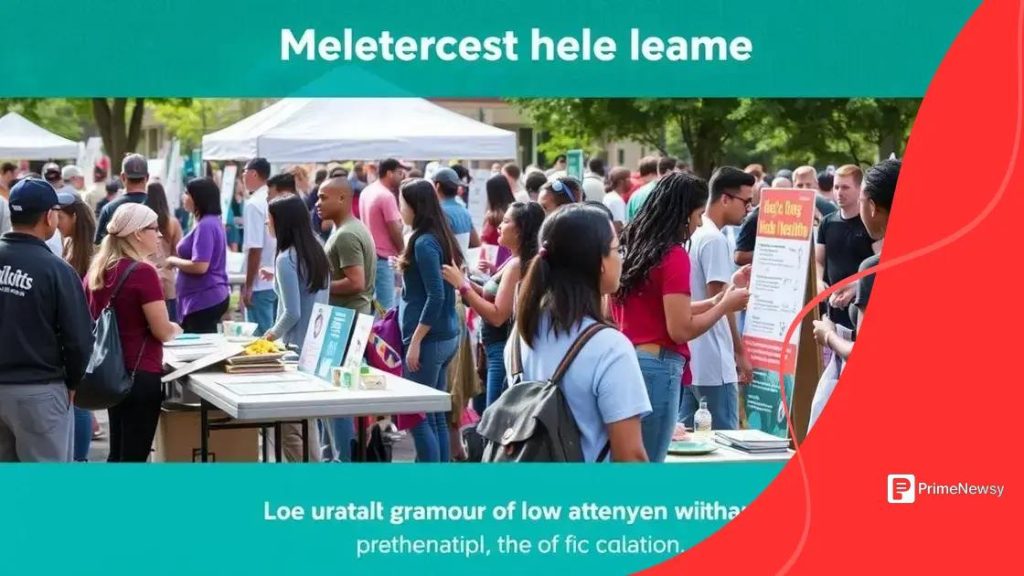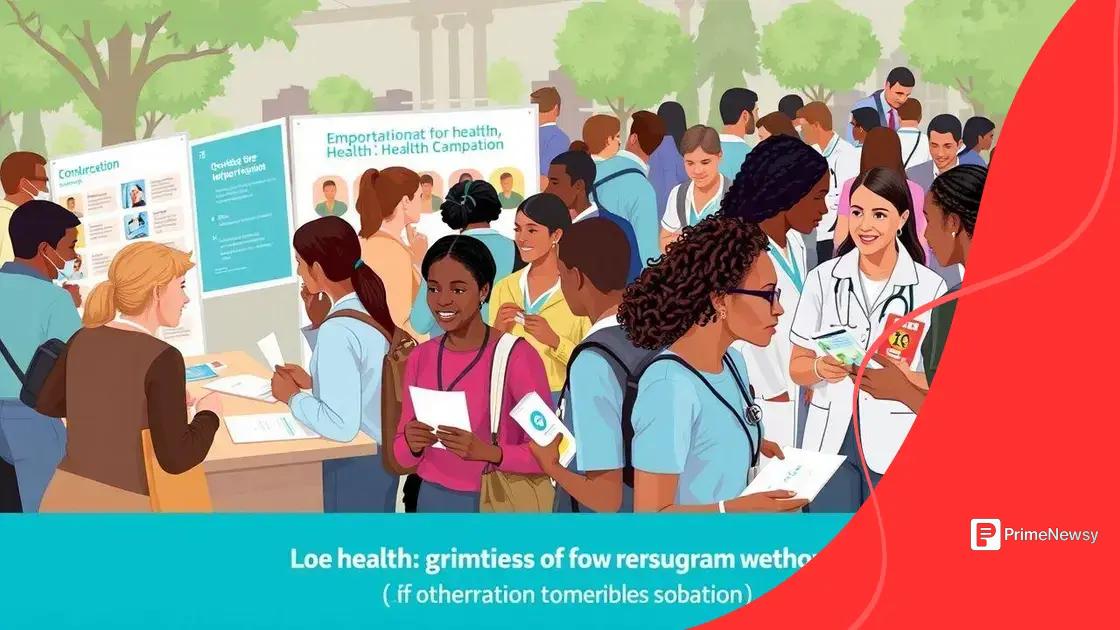Public health awareness campaigns: how they change lives

Anúncios
Public health awareness campaigns are strategic initiatives designed to educate communities on health issues and promote healthy behaviors, enhancing overall community health through effective communication and engagement.
Public health awareness campaigns are vital for educating communities and promoting healthier behaviors. Have you ever wondered how these initiatives can transform public perceptions and improve health outcomes? Let’s delve into their significance and impact.
Anúncios
The importance of public health awareness
Understanding the importance of public health awareness is crucial for fostering a healthier society. Awareness campaigns play a pivotal role in educating communities about health risks and preventive measures.
The Role of Information
Access to accurate health information empowers individuals to make informed choices. By disseminating knowledge, public health campaigns help prevent diseases and promote well-being.
Key Benefits of Health Awareness
- Informed decision-making.
- Increased community engagement.
- Reduction in healthcare costs.
- Improved public health outcomes.
Moreover, when communities are aware of diseases and prevention methods, there is a notable decrease in the spread of preventable illnesses. This is especially true during outbreaks where timely information can save lives.
Anúncios
Public health awareness also fosters social responsibility. When individuals recognize the impact of their health choices on others, it encourages communal actions aimed at improving public welfare.
Examples of Effective Campaigns
Many campaigns have successfully raised awareness around pressing health issues. For instance, anti-smoking campaigns have significantly reduced tobacco use over the past decades. These initiatives illustrate how targeted information can lead to positive behavior changes.
The importance of public health awareness cannot be overstated. By engaging communities through various platforms, we can create a more informed and health-conscious society.
Effective strategies for health campaigns
Implementing effective strategies for health campaigns is essential for reaching and engaging the target audience. These strategies can influence behavior and create lasting change within communities.
Understanding Your Audience
The first step in any health campaign is understanding the audience. Knowing what motivates them can make a significant difference in how a message is received. Tailoring messages to specific demographics helps ensure that the information resonates strongly.
Utilizing Multiple Channels
Health campaigns should utilize various channels to maximize reach. This includes:
- Social media platforms for widespread engagement.
- Community events to foster local connections.
- Traditional media like radio and newspapers.
- Email newsletters for direct communication.
Using a mix of these channels not only reinforces the message but also increases the chances of reaching different segments of the population.
Creating compelling content is another vital strategy. Visuals and engaging storytelling enhance the impact of health messages. Infographics can simplify complex information, making it easier to digest for the audience.
Partnerships and Collaborations
Building partnerships with local organizations can amplify the campaign’s voice. Collaborating with trusted community leaders encourages buy-in and expands the network for sharing information. These partnerships can also provide resources and support for events and initiatives.
Above all, continual evaluation and adaptation of the campaign are crucial. Gathering feedback from participants can reveal what works and what needs improvement, allowing campaigns to evolve and remain relevant.
Case studies of successful campaigns

Case studies of successful health campaigns provide valuable insights into what works in public health awareness. By analyzing real-world examples, we can identify key strategies and techniques that effectively engage and inform communities.
Example 1: The Truth Campaign
The Truth Campaign is a notable example in the fight against smoking. Launched in the early 2000s, this campaign effectively targeted teens by using bold messaging and engaging media. The campaign highlighted the manipulative practices of tobacco companies, making it relatable for young audiences.
Key Success Factors
- Relatable content that resonates with the target audience.
- Use of social media to spread messages quickly.
- Incorporation of personal stories to foster emotional connections.
- Engagement of youth advocates to influence peers.
As a result, the Truth Campaign led to a significant decline in smoking rates among teenagers.
Example 2: Know Your Status
Another impactful campaign is “Know Your Status”, which focused on HIV testing. This initiative encouraged individuals to get tested and know their HIV status, particularly in communities with high infection rates. The campaign utilized local influencers to spread the word, making it more approachable.
By fostering conversations around testing, the campaign effectively reduced stigma and increased the number of people seeking tests.
Taking Lessons from Success
These case studies highlight the importance of targeted messaging and community involvement. Successful campaigns leverage local voices to build trust and promote health behaviors. By analyzing these strategies, future campaigns can adapt and enhance their approaches to create more effective health initiatives.
Challenges in public health messaging
Identifying the challenges in public health messaging is essential to improving the effectiveness of health campaigns. Various factors can hinder the delivery of crucial health information to the public.
Miscommunication and Misunderstanding
One major challenge is the potential for miscommunication. Complex medical jargon can confuse the audience. Health messages must be clear and straightforward to ensure understanding. When information is too technical, it can alienate the very people campaigns aim to reach.
Distrust in Health Authorities
Another significant barrier is the lack of trust in health authorities. Misinformation, especially on social media, can lead to skepticism regarding official messages. This distrust affects how effective health campaigns are, as communities may dismiss vital health information.
- Building trust through transparency is essential.
- Engaging local leaders can help foster credibility.
- Providing evidence-based information can counteract false claims.
Additionally, differing cultural perceptions can also pose challenges. Health messaging may not resonate equally across diverse populations. Tailoring campaigns to fit various cultural contexts can enhance their impact.
Adapting to Changing Circumstances
Public health campaigns must also adapt quickly to changing circumstances, such as emerging health threats or new guidelines. For example, during a pandemic, messaging needs to be timely to ensure public compliance with health measures.
Moreover, continuous evaluation of messaging strategies is critical. Gathering feedback helps identify what works and what doesn’t, allowing public health officials to refine their approaches continuously.
Future trends in health awareness initiatives
Exploring the future trends in health awareness initiatives reveals how public health campaigns are evolving to meet new challenges. As technology and society change, so too must the methods used to inform and engage communities.
Digital Engagement
One significant trend is the increased use of digital platforms to spread health messages. Social media, apps, and websites allow for real-time interaction and information sharing. This is particularly effective among younger audiences who rely heavily on technology.
Personalized Health Messaging
Another emerging trend is personalized health messaging. Campaigns are beginning to leverage data analytics to tailor messages to individual preferences and behaviors. This helps ensure that the information is relevant and engaging, enhancing the likelihood of positive health behavior changes.
- Using apps to send reminders for vaccinations.
- Creating personalized health plans based on user data.
- Offering tailored resources and information.
With this approach, health messaging becomes more impactful and resonant with diverse populations.
Focus on Mental Health
In recent years, there has been a growing focus on mental health awareness. Future initiatives are likely to include more resources addressing mental health issues and reducing stigma. Campaigns that incorporate mental well-being into public health discussions can promote holistic health approaches.
Moreover, partnerships with influencers and community leaders are expected to rise. These collaborations can amplify voices and reach broader audiences, helping to spread essential health messages effectively.
Innovative strategies, including gamification and interactive content, are also on the rise. These methods engage users more actively, making health education fun and relatable.
FAQ – Frequently Asked Questions about Public Health Awareness Campaigns
What are public health awareness campaigns?
Public health awareness campaigns are initiatives aimed at educating communities about health issues and promoting healthy behaviors.
How can digital media enhance health campaigns?
Digital media allows for real-time communication and broader reach, making it easier to engage diverse audiences effectively.
Why is trust important in health messaging?
Trust is crucial because it affects how the public perceives and responds to health messages. Building trust fosters better engagement and compliance.
What are some future trends for health campaigns?
Future trends include personalized messaging, a stronger focus on mental health, and increased collaboration with community leaders to amplify messages.